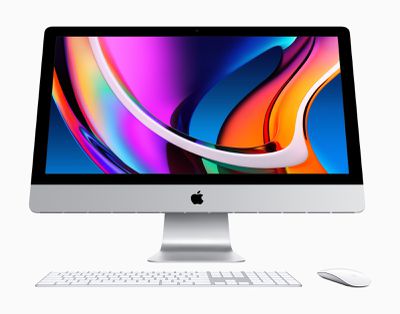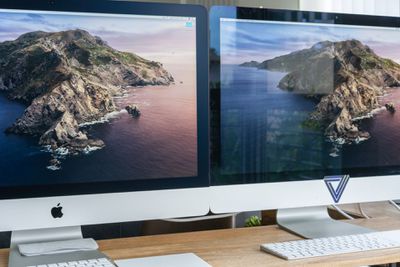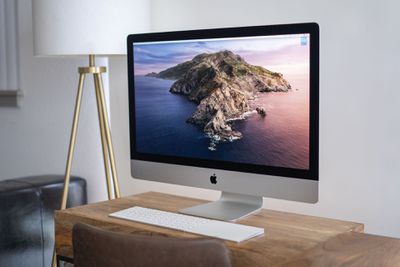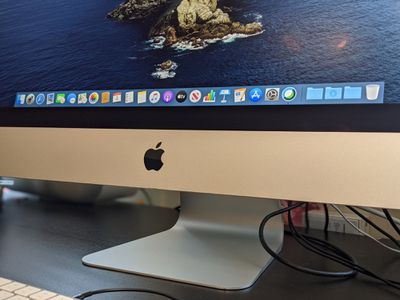The 2020 27-inch iMac was announced earlier this week with updated 10th-generation Intel chips, new AMD 5000 graphics, a True Tone display, and an improved webcam, but unfortunately, the machine features no design changes. Apple began shipping iMac orders out earlier this week, and as the new devices arrive to customers, media sites have also released their own reviews.

Many of the reviews have pointed out that the new iMac is great for working from home, highlighting the upgraded 1080p webcam, improved speakers, and new microphone array as noteworthy features.
True Tone Display
The iMac features the same 5K display that's been used in prior generations with millions of colors, 14.7 million pixels, and 500 nits brightness, but it also features True Tone for the first time, allowing the color temperature of the display to be adjusted to the ambient lighting.
Most reviewers didn't have too much to say about True Tone because we've been using it for years in other Apple products, but TechCrunch called it a nice addition:
This is the first time the company has brought True Tone technology to the iMac, using light sensors to adjust the screen to more true to life colors. It's a nice addition, and it all leads to a screen that positively pops. At the end of a long day, I've taken to swiveling the iMac around and using it to watch movies from my couch.
Nano-Texture Glass
Apple added the same nano-texture matte glass option to the iMac that it first introduced with the Pro Display XDR.

Not all reviewers received an iMac with nano-texture glass, but those that did were impressed. From Gizmodo:
I absolutely love this glass, though. There's absolutely no glare, at any angle, regardless of what I'm watching or the ambient light in the room. Bright light streaming in from the giant window to my left while watching Tom Hanks' dimly lit drama-on-the-high-seas flick Greyhound (on Apple TV+, natch) was no match for the nano-textured glass. Late afternoon sun hitting the display from behind my shoulder wasn't reflected in the screen one bit. I need this on every device in my life.
The Verge said the nano-texture is "great," but questioned whether it was worth the $500 price tag given that there are unknowns about durability.
My first two big reservations are, unfortunately, the sorts of things that can't be resolved with just two days of testing. One is the price: at $500, it's a super expensive upgrade, and only your tolerance for glare can tell you if it's worth the price. Another thing that might help you decide if it's worth is whether the finish is durable. That's my second reservation: I just don't know. [...]
I asked Apple about the durability of the finish. I was told that they don't want to give anybody the impression that it's fragile, but that, yes: over time, using something too abrasive could mess up that finish. Unlike other screens, there's really no coating on top of the nano finish; it's just etched, bare glass.
Mashable said the nano-texture glass gives the iMac "an updated look" and said it's fingerprint resistant.
While it's not all that noticeable unless you physically feel it, it gives the iMac an updated look. More importantly, it reduces glare and reflectivity, and makes everything look a lot more vibrant. And, unlike the standard glossy display, it's not a fingerprint magnet.
10th-Generation Processors and Radeon GPUs
Gizmodo was impressed with the performance and called the 10-core iMac it tested a "powerhouse" that will last for years to come.
The couple of benchmarks I've run since the iMac arrived on Tuesday indicate that this desktop is a powerhouse. In the Blender test of CPU performance, the iMac rendered an image in 2 minutes and 19 seconds, which is incredibly fast--it's more than two minutes faster than when we benchmarked Intel's 10th-gen Core i9-10900K processor on its own. On Geekbench 4, a synthetic test of overall system performance, the iMac's single-core score of 6382 and multi-core score of 42417 impressed us all. Joanna Nelius, Gizmodo's resident PC and processor expert, exclaimed: "What the hell did Intel do to this CPU?" We plan to run more benchmarks in addition to real-world tests, but these early numbers are promising.
Mashable said that its 10-core review unit with 32GB RAM and Radeon Pro 5700 XT graphics card was too powerful for everyday use.
My review unit was a bit too powerful for my everyday tasks: a 3.6 GHz 10-Core Intel Core i9 processor, 32GB of storage, and that aforementioned Radeon Pro 5700 X graphics card. I can easily say it handled everything I threw at it with ease, but my typical workday doesn't require all that much heavy lifting in terms of hardware.
1080p Camera
The iMac uses an upgraded 1080p camera that's also been improved with the T2 chip, which adds an image signal processor that includes tone mapping, exposure control, and face detection.

TechCrunch says the camera is clear and "more than acceptable for teleconferencing needs."
The system sports a number of on-board sensors designed to augment the experience, including face tracking for better shot framing and increased performance in low light.
CNBC liked the face tracking feature that was included because it keeps your face in focus.
Apple tweaked the camera software so that your face is always in focus, even if you move it around the screen, and it does a good job keeping you well-lit even in a relatively dark environment. That's important, say, when you're on a video chat with your team during a cloudy day and don't want it to look like you live in a cave.
The Verge said that for videoconferencers, the 1080p webcam is likely to be the biggest day-to-day improvement.
But there's one spec bump that is wildly out of character for Apple, even in this pandemic year: the quality of the webcam has finally been improved. If you're videoconferencing a lot, the new 1080p webcam is likely going to be the thing that improves your day-to-day the most. I hate to tell you this, but you really do look more professional to your colleagues when your camera is just a little sharper. I don't think it's worth upgrading to a new iMac just for the webcam, of course, but I am glad that Apple has made it better. I also don't know that I'd say it's the best I've used, but it's no longer vaguely embarrassing like most of Apple's other webcams.
Microphone and Speakers
The microphone also got a boost, with Apple adding a studio quality microphone array to accompany the higher-end camera, while the speakers benefitted from the T2 chip, gaining variable EQ for improved balance, higher fidelity, and deeper bass

TechCrunch deemed the microphone "clear and perfectly suited to teleconferencing," and had the same thing to say about the speakers.
The speakers, too, fill roughly the same needs. They're perfectly good for a teleconference, audio playback and even casual movie watching and music listening. As someone who's slightly obsessive about music listening, I would likely invest in some external speakers to pair with the desktop in the home setting, but the computer audio is well suited for an office.
CNBC: Called the microphone excellent, and said that it a recording made with the microphone sounded like it came from a studio.
The microphones are excellent. Previous iMacs had two front-facing microphones but the new 27-inch iMac adds a third rear-facing one to cut down on background noise. I had a 90-minute video chat last night with folks who were also using the new 27-inch iMac and they sounded really clear. I also heard a demo track recorded by a musician named Mary Spender who recorded herself singing and playing guitar in front of the iMac. I'm no audiophile, but it sounded really clear to me, like it was recorded in a studio.
Complaints
There were few complaints about the new iMac, but almost all of them focused on the outdated design of the machine. The iMac's design has not been overhauled since 2012 and it continues to feature thick borders.
Some reviewers also expressed interest in the addition of a Touch ID Home Button, which is on Macs like the MacBook Air and MacBook Pro, but not the new iMac. From The Verge:
One thing that doesn't feel modern at all with the 2020 iMac is logging in. Unless you have an Apple Watch and use it to unlock your computer, the only way to get in is to type out your password like an animal. Apple's T2 chip controls Touch ID fingerprint login on Mac laptops, but Apple opted not to add a fingerprint sensor to the keyboard or a Face ID array in this iMac.
Review Videos
A number of YouTubers made hands-on videos with the new iMac for those interested in seeing it in action.
Full Reviews to Read: Six Colors, Mashable, CNBC, TechCrunch, Gizmodo, Pocket-lint, and The Verge.
























Top Rated Comments
Like an animal?? Animals can type passwords? ??
At least my late 2015 27" 5K looks the same as the current models, for just a while longer.
Given that people still use PowerPC Macs... 15+ years?
Source ('https://www.apple.com/shop/buy-mac/pro-display-xdr'): "While both the standard glass and nano-texture glass options of Pro Display XDR are engineered for extremely low reflectivity, it helps to consider your work environment when deciding which one is right for you.
If you’re in an especially uncontrolled lighting environment, there’s an innovative matte option with nano-texture glass. Typical matte displays have a coating added to their surface that scatters light. However, these coatings lower contrast while producing unwanted haze and sparkle. The nano-texture on Pro Display XDR is actually etched into the glass at the nanometer level. The result is a screen with beautiful image quality that maintains contrast while scattering light to reduce glare to the barest minimum."